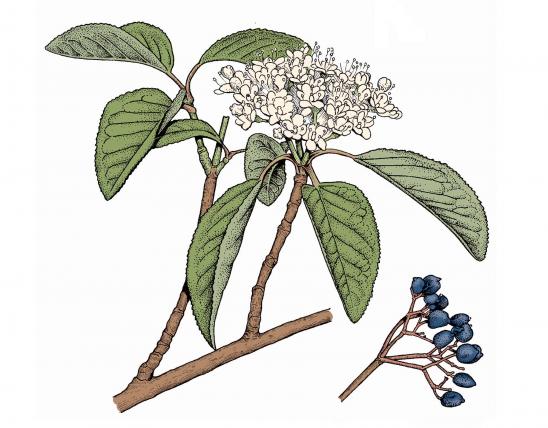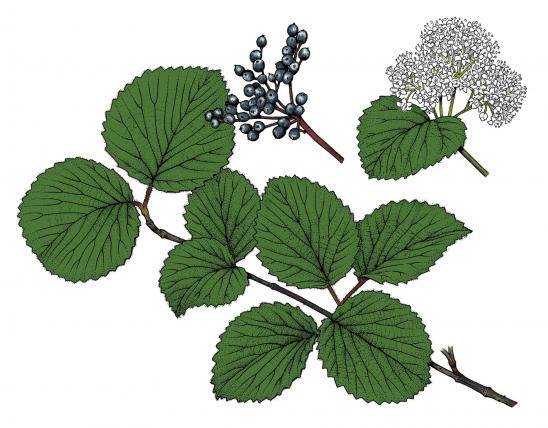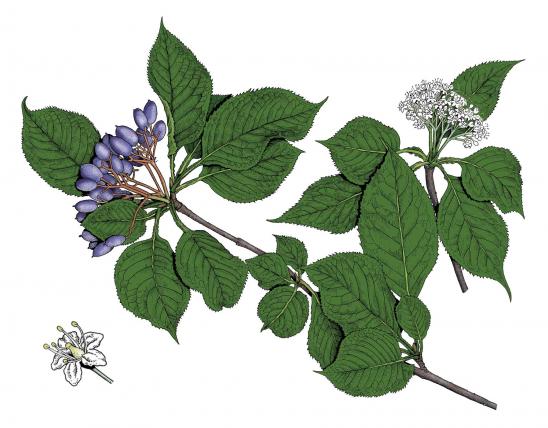
Southern black haw is an irregularly branched shrub with thick, shiny, dark green, opposite leaves. The leaf stems, main veins on the leaves’ undersurface, and winter buds are densely hairy with red to rusty, branched, woolly hairs. It bears clusters of white flowers, which turn into bluish-black fruits.
Leaves are opposite, simple, the blades to 4 inches long and to 2½ inches wide, broadest at or above the middle, the tip rounded to pointed, the base heart-shaped or rounded, the margin finely toothed; the upper surface dark green, leathery, glossy, smooth; the lower surface paler, with scattered rust-colored hairs especially on the veins. Leaf stalk about ¼ inch long, sometimes with a wing; smooth; broadly grooved above. Leaves turn shades of deep purple to bright red in fall.
Bark is rather rough, the ridges narrow and rounded, the grooves narrow, breaking into dark reddish brown or black, fairly square plates.
Twigs are fairly rigid, gray brown, smooth, lightly to densely matted with rust-colored hairs (when young), becoming nearly smooth later.
Flowers April–May, in flat clusters 2–6 inches wide; flowers numerous, white, about ¼ wide; petals 5, spreading, the tips rounded; stamens 5, extending beyond the petals.
Fruits in September, in drooping clusters, the stalks red; fruit about ⅜ inch long, bluish black, smooth, oval, the skin smooth and tough, the flesh mealy, sweet, and edible; seeds solitary, oval, flat, dark brown.
Similar species: Take note of southern black haw’s shiny leaves with the paler lower surface and rusty hairs along the veins, and the rusty hairs on young twigs. The viburnum called “black haw” (V. prunifolium) is closely related to southern black haw, and young plants of the former species sometimes have hairiness approaching that of southern black haw.
Ten species in genus Viburnum are known to grow wild in our state. Viburnums can be difficult to identify to species, involving (for example) fairly fussy characteristics of the leaves, such as leafstalk length, venation patterns, the number of teeth along one side, and other precise details.
Height: to 18 feet.
Scattered south of the Missouri River and in northeastern Missouri. Potentially cultivated elsewhere.
Habitat and Conservation
Occurs in bottomland forests, rich, moist to dry upland forests, banks of streams, rivers, and spring branches, edges of glades, and bases and ledges of bluffs; also fencerows, pastures, railroads, and roadsides.
Status
Native Missouri shrub; worthy of cultivation for its ornamental qualities and value for wildlife.
Human Connections
Southern black haw is a shrub worthy of cultivation because of its ornamental qualities: attractive dark green, shiny leaves that turn beautiful deep rose purple to rose red or bright red in fall; showy springtime clusters of white flowers; and handsome blue-black, berrylike fruits. The fruits, in turn, attract birds.
The bark of viburnums has been used for a variety of medicinal uses.
The fruits of some species of viburnums are sometimes eaten raw, cooked, or processed into preserves and jellies.
Many Asian species of viburnums have been introduced into horticulture, and several have been reported to escape in other states. However, only two Old World species (V. lantana, called wayfaring tree or twistwood, and V. opulus, called Guelder rose or snowball shrub) are known to have become established in Missouri. Meanwhile, some of Missouri’s native species are widely planted, too, and they sometimes escape into areas outside their native ranges.
Ecosystem Connections
Southern black haw has considerable wildlife value. Numerous insects visit the flowers, including a wide variety of native bees, flies, butterflies, moths, ants, and more. The leaves, flowers, or both of viburnums are food for the caterpillars of at least a dozen species of moths and butterflies, including the beautiful Baltimore checkerspot. The aptly named viburnum leaf beetle (Pyrrhalta viburni) also dines on the foliage.
The leaves and twigs are eaten by deer and beaver. The fruits are eaten by many species of birds, including northern cardinals, cedar waxwings, American robin, ruffed grouse, and wild turkey, and by mammals such as deer, rabbits, chipmunks, squirrels, skunks, and mice.
Southern black haw is a shrubby component of thicket habitats, which provide important cover and nesting space for many kinds of animals.




























